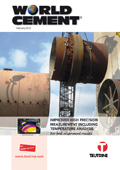Editorial comment
This issue features a heavy focus on plant maintenance. It’s that time of year for many of you, after all. The importance of properly maintaining equipment is well known, and the cost savings that can be achieved are highlighted in the articles included herein. If you’re looking for quantifiable evidence that a proactive approach to maintenance works, the article from Dr Klaus Blache of the University of Tennessee (page 57) provides just that. Moreover, as you come to the end of your annual maintenance outage, it is worth reviewing the articles from Strategic Maintenance (page 51) and GPAllied (page 63), which could help you plan for the next shutdown. Improving efficiency and effectiveness are the watchwords in this feature, which gives a comprehensive overview of all things maintenance.
Register for free »
Get started now for absolutely FREE, no credit card required.
What is not discussed in detail is the safety element of plant maintenance. In the last week, as this issue was being prepared, there have been two serious maintenance-related accidents at UK cement plants, one of them fatal. I received a phone call from a reporter local to one of these accident sites, and though the question asked was ‘Does this sort of thing happen often?’, the implied question was ‘How can this still be happening?’.
Why does this still happen? Part of the problem – and from initial reports it seems that this may also apply to these two cases – is that workers called in to complete plant maintenance tend to be contractors, not assimilated into the plant’s safety culture. Of course there isn’t room to explain this in the headlines, and it is ultimately the plant’s responsibility to ensure the safety of everyone on site. Another problem is that regular exposure to risk desensitises people to that risk. Having operated accident-free for a certain amount of time, people can begin to feel untouchable; they get cocky; they cut corners. This can apply to both regular plant workers and contractors. I have had conversations with people in the cement industry who have experienced the ‘near miss’ that frightened them into re-prioritising safety, but how long does this last?
Maintaining an emphasis on safety requires constant vigilance. Regular readers may remember an article from Titan Cement and DuPont, published in the February issue last year. It described the process of enforcing a strict safety policy during the construction of a second line at Beni Suef in Egypt. This policy applied to Titan personnel, contractors and sub-contractors, and its implementation was audited to ensure compliance by all parties – to the point that those who did not conform to the plant’s strict safety standards were not allowed to continue working on the project. Clichéd as it sounds, failure was not an option, and Titan managed to complete the new line with zero injuries.
If you have had similar success with your safety policy, I would like to hear from you. You can get in touch via email at the address above, or why not share your story with our World Cement LinkedIn group? Just type ‘World Cement LinkedIn’ into your search engine to find us and join in the discussion.


